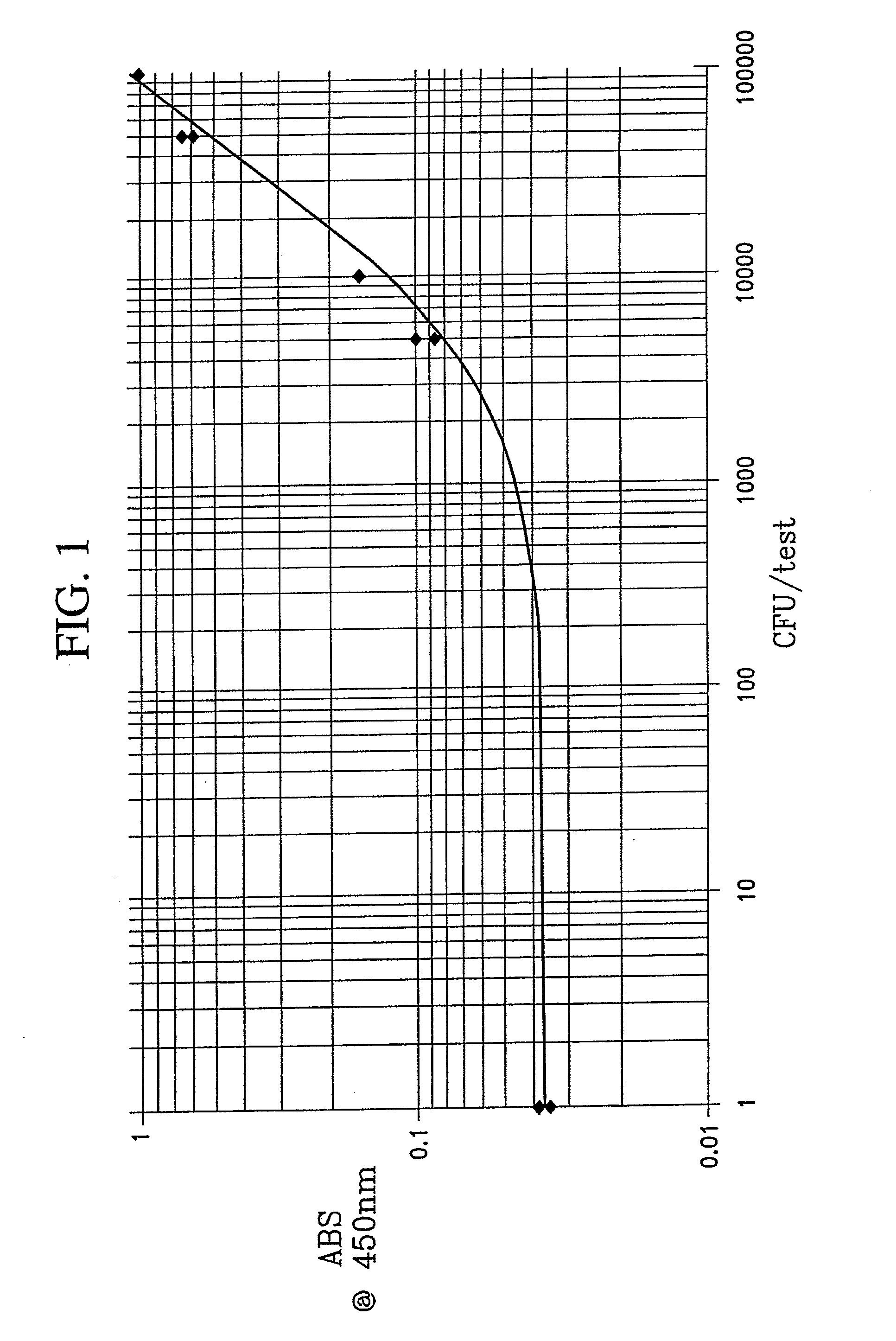EIA for monitoring legionella pneumophila presence in water samples
a technology of legionella pneumophila and water sample, which is applied in the field of eia for monitoring legionella pneumophila presence in water samples, can solve the problems that the application of this test found it to be somewhat useful, and the inability to achieve the differentiation of the assay result with the test sample against a blank run, etc., and achieves high sensitivity and accuracy.
- Summary
- Abstract
- Description
- Claims
- Application Information
AI Technical Summary
Benefits of technology
Problems solved by technology
Method used
Image
Examples
example 1
ICT Test
[0024]A. Preparation of Test Device
[0025]The ICT device is generally described, and also depicted in drawings, in the parent application. Its preparation, including the preparation and construction of the test strip, is described in Example VII of the parent application.
[0026]B. Immunoassay Procedure
[0027]Several samples of water were run on identically prepared ICT devices. The first such sample was tap water to which Legionella pneumophila serogroup 1 bacteria obtained originally from Centers for Disease Control and grown in culture had been added up to a level of about 50 CFU per ml. Initially, 1,000 ml. of this water was put through a filtration unit having a Gelman GN-6 Metricel® grid filter of 0.45 μm pore size and a 47 mm. diameter. The filtrate was discarded. The sample was collected from the material on the filter using a swab with a fibrous Dacron pad which was stroked thoroughly across the surface of the filter. The swab was then inserted into the device in the ma...
example 2
EIA Test
[0032]This example describes Applicants' preferred embodiment of the modified EIA assay for on-site testing of water samples for L. pneumophila serogroup 1. As already discussed to some extent and as those of ordinary skill in immunology will readily perceive, this assay can be designed to operate in numerous modes that are well known in the art, using various devices such as coated solid inserts or coated beads in lieu of coated tubes and using other enzymes and chromogenic reagents, or by using chemiluminescent or bioluminescent tags plus an instrument to read the result. So long as such other modes employ the antigen-specific anti-bodies of this invention, produced by the affinity purification process as described in the parent application, employing the O-polysaccharide antigen described in that application, they are within the scope of this invention.
[0033]A. Preparation of Coated Tubes
[0034]Nunc Star tubes were coated with the antigen-specific affinity purified antibod...
example 3
[0042]A series of quantitative EIA's for L. pneumophila serogroup 1 were run in the same coated tubes described in Example 2, with a longer incubation time and color development period, followed by reading the absorbance at 450 nm of each tube using a Beckmann spectrophotometer.
[0043]The samples for these runs were prepared by adding to tap water incremental amounts of 5×103, 1×104, 5×104 and 1×105 CFU per test of cultured L. pneumophila serogroup 1 that had first been rendered nonviable with formalin. Duplicate runs were made at the 5×103 and 5×104 levels. Two blank runs were made with no bacteria (and hence no antigen) present.
[0044]In all cases, the conjugate, assay buffer and wash solution were the same, and their amounts were the same, as in Example 2. The incubation time for the coated tube containing assay and buffer was 60 minutes in each run. After the tubes were thoroughly washed as described in Example 2, K-Blue was added to each tube in the amount described in Example 2....
PUM
| Property | Measurement | Unit |
|---|---|---|
| volume | aaaaa | aaaaa |
| pore size | aaaaa | aaaaa |
| pore size | aaaaa | aaaaa |
Abstract
Description
Claims
Application Information
 Login to View More
Login to View More - R&D Engineer
- R&D Manager
- IP Professional
- Industry Leading Data Capabilities
- Powerful AI technology
- Patent DNA Extraction
Browse by: Latest US Patents, China's latest patents, Technical Efficacy Thesaurus, Application Domain, Technology Topic, Popular Technical Reports.
© 2024 PatSnap. All rights reserved.Legal|Privacy policy|Modern Slavery Act Transparency Statement|Sitemap|About US| Contact US: help@patsnap.com









